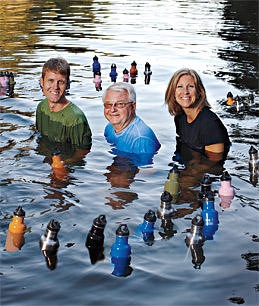
The Cresswell family saw potential in Klean Kanteen and stainless steel's long life cycle.
Ruth Elliott once thought nothing of carrying her drinking water in a Nalgene polycarbonate bottle, the plastic container that many bikers, hikers and babies use. But she began to notice more people in her Santa Cruz, Calif., neighborhood transporting their H2O in sleek stainless-steel receptacles. Early this year she joined the growing cadre of metal toters when she plunked down $25.95 for a 40-oz. (1.2 L) stainless bottle. What swayed Elliott, 32, was Canada's decision in late 2007 to reassess a substance found in polycarbonate — bisphenol A (BPA), an estrogen mimicker linked to several medical conditions and diseases.
That the U.S. Food and Drug Administration (FDA) announced in a draft report on Aug. 15 that the trace amounts of BPA found in polycarbonate containers do not pose a threat to infants or adults mattered not a whit to Elliott, or to the many others who have heeded the advice of some experts who disagree with the FDA. (Canada has announced it will ban the import and sale of polycarbonate baby bottles.)
The groundswell of demand has helped producers of stainless bottles experience a huge surge in sales, seemingly overnight. But the switch has also created its own set of management, environment and trade issues for the lucky manufacturers. One winner is Klean Kanteen, in Chico, Calif., which projects 2008 revenues of $18 million, up from $2.5 million in 2007 and less than $1 million in 2006. Guyot Designs, in Deer Isle, Maine, another stainless-bottle maker, also saw its business do a 180. Guyot projects revenues of $5 million this year, 60% of that from stainless-bottle sales. In 2007, those bottles accounted for only $60,000 of revenue.
Klean Kanteen anticipated the demand several years ago. In early 2004, small-business owners Darrel Cresswell and his children Jeff Cresswell and Michelle Kalberer became the order-fulfillment contractors for the inventor of a 27-oz. (.8 L) stainless bottle called Klean Kanteen. The more bottles the siblings shipped, the more buzz they heard. "We recognized the potential of stainless steel's long life cycle and thought the bottle had really huge potential if marketed correctly," says Jeff Cresswell. Eventually, the family became owners of the company.
Guyot Designs recently experienced its own dizzying trajectory. Established in 2002 to provide accessories for Nalgene bottles, Guyot — Josh Guyot is product designer and his wife Sloan Russell is president — debuted four stainless-bottle designs in 2005. "We were aware the market was changing," says Russell.
But not as fast as they thought. Initially, their bottles didn't sell, and the company dumped its stainless inventory at cost two weeks before Canada's BPA-related announcement late last year. When a large Canadian outdoor-product retailer pulled polycarbonate bottles off its shelves, Guyot got bombarded with "gigantic orders" and was left scrambling. "We made two trips to China to convince our factory — they thought we were crazy — to make more tools, and we still missed many deadlines," says Russell. Klean Kanteen's two factories in China also had to install more equipment. With weekly shipments averaging 50,000 bottles, the company is just now catching up with orders.
Some consumers find themselves in a quandary over environmental issues. While enthusiastic about stainless's recyclability, they're dismayed by China's manufacturing processes, which are not always the greenest. Guyot's Russell uses a third-party verification team to monitor its factory, and the company offsets all carbon emissions resulting from the production process.
Despite the controversies, as well as the FDA's most recent evaluation of BPA and the new BPA-free plastic bottles perched on retailers' shelves, the demand for stainless bottles has not abated. "A slight dip in sales" would be Cresswell's worst-case scenario. "The replacement for polycarbonate is still plastic, and there's a psychological reserve that plastic is bad," says Russell. Which makes the outlook for stainless appear shiny.